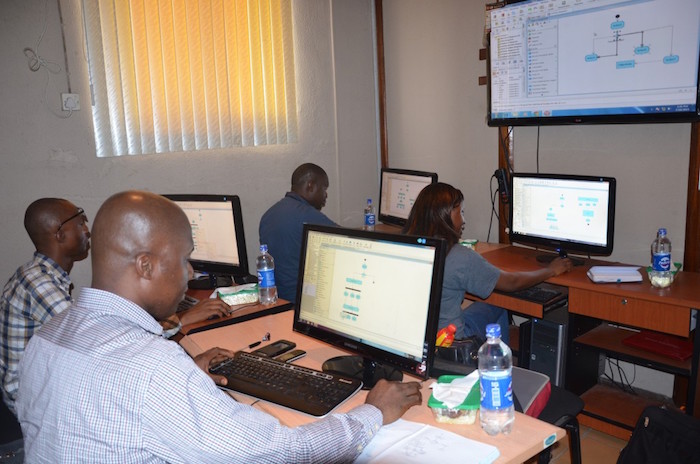Increase your odds of passing the CCBA or CBAP Exam with PMtutor. According to INDEED, the average salary of a Business Analyst is 74, 000 US Dollars. This is justified because projects are not delivering the intended business value. According the 2014 survey by PMI, poor Business Analysis practice was reported by 37% of the organization as a primary cause of project failure and the second leading cause of project failure second to changing organization priorities. A Business Analyst identifies and determines a NEED, recommends a viable SOLUTION through eliciting and managing stakeholder requirements. Click FAQ here to know more about Business Analyst and Training.

Above Picture: June 2015 Business Analyst Delegates using UML Diagram to model a Business Process
Benefits
- 100% Money-Back Guarantee if you do not pass the CBAP exam at first try
- This is complete PRACTICAL COURSE but covers the BABOK
- 7-Days of Interactive but rigorous Virtual training
- All exam concepts explained
- Easy to follow modules
- Makes you study faster and easier
- Cuts your studying time significantly
- Focus on understanding rather than memorization
- Save money. Up to N125, 000 vs. other courses
- 35-Contact Hours Certificate
______________________________________________________________________________
PMtutor Business Analyst Virtual Live Training
TRAINING FEE: N120, 000
DATE: 27th November 2021
TIME: 7 am to 11 am
DAYS: Saturdays and Sundays
PREREQUISITE: Laptops, notebooks, net-books or tablets are compulsory!
______________________________________________________________________________
PAYMENT INFORMATION: Monies can be paid to:
Access Bank
Poet Solvers Limited
0006551542
______________________________________________________________________________
Snapshot of the Our approach to the Business Analyst Knowledge Area.
CBAP® CCBA Exam Information & Tips
-
- Overview of certification process, eligibility requirements, and application tips
- CBAP® Exam overview
- Studying tips
- CBAP Study Guide overview
- Course layout
- BABOK overview & structure
- Key knowledge areas
- Common themes
- Business Analysis Core Model
- Key BABOK® Terminology
- Classification of Requirements
- Key Stakeholders
- Practice Exam Questions & Review
- Overview
- KA Goal & things to note
- Exam Blueprint
- Common Themes
- Core Concept Model
- Key Tasks
- Stakeholders
- Techniques
- Guidelines & Tools
- Practice Exam Questions & Review
- Overview
- KA Goal & things to note
- Exam Blueprint
- Common Themes
- Core Concept Model
- Key Tasks
- Stakeholders
- Techniques
- Guidelines & Tools
- Practice Exam Questions & Review
- Overview
- KA Goal & things to note
- Exam Blueprint
- Common Themes
- Core Concept Model
- Key Tasks
- Stakeholders
- Techniques
- Guidelines & Tools
- Practice Exam Questions & Review
- Overview
- KA Goal & things to note
- Exam Blueprint
- Common Themes
- Core Concept Model
- Key Tasks
- Stakeholders
- Techniques
- Guidelines & Tools
- Practice Exam Questions & Review
- Overview
- KA Goal & things to note
- Exam Blueprint
- Common Themes
- Core Concept Model
- Key Tasks
- Stakeholders
- Techniques
- Guidelines & Tools
- Practice Exam Questions & Review
- Overview
- KA Goal & things to note
- Exam Blueprint
- Common Themes
- Core Concept Model
- Key Tasks
- Stakeholders
- Techniques
- Guidelines & Tools
- Practice Exam Questions & Review
- Overview
- Analytical Thinking and Problem Solving
- Behavioral Characteristics
- Business Knowledge
- Communication Skills
- Interaction Skills
- Tools & Technology
- Practice Exam Questions & Review
- Overview
- Review of each technique (Usage, Purpose & Key elements)
- Technique Examples
LEARNING OBJECTIVES
Upon completion of the course, you will be able to:
- Describe the responsibilities of the business analyst and the major deliverables for each major step in the business solutions life cycle
- Distinguish between the role of the business analyst and the project manager
- Distinguish between the role of the business analyst and the systems analyst
- List the critical skills needed to be a successful BA
- Define business problems and find their true cause
- Develop tactics for diffusing resistance to change
- Prepare a stakeholder analysis to identify and classify those who will influence and be affected by the solution
- Create and execute a Requirements Development plan
- Use modelling tools and techniques to elicit, document and validate a project’s scope and requirements highlights
- Use business analysis & project management tools
- Assist decision-makers in analyzing and prioritizing business needs
- Create a business case Communicate the results of a business case to stakeholder
______________________________________________________________________________
